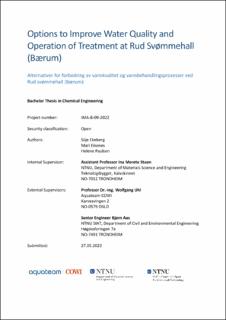| dc.contributor.advisor | Stuen, Ina Merete | |
| dc.contributor.advisor | Uhl, Wolfgang | |
| dc.contributor.advisor | Aas, Bjørn | |
| dc.contributor.author | Paulsen, Helene | |
| dc.contributor.author | Eikenes, Mari | |
| dc.contributor.author | Ekeberg, Silje | |
| dc.date.accessioned | 2022-07-19T17:22:25Z | |
| dc.date.available | 2022-07-19T17:22:25Z | |
| dc.date.issued | 2022 | |
| dc.identifier | no.ntnu:inspera:113593029:113594768 | |
| dc.identifier.uri | https://hdl.handle.net/11250/3007029 | |
| dc.description.abstract | Mennesker forurenser svømmebasseng med ulike stoffer, slik som svette, urin, hår, kosmetikk og døde hudceller. Uten behandling vil disse stoffene lagres i vannet over tid. Det er dermed viktig med gode vannbehandlingsprosesser for å minimere konsentrasjonen av disse stoffene. Vannbehandling involverer ofte tilsetting av en koagulant som danner flokker, hvor disse videre kan fjernes i et aktivert glassfilter (AG). Videre fjernes organiske molekyler fra vannet ved hjelp av et granulært aktivt karbonfilter (GAC). Før vannet reintroduseres til bassenget, desinfiseres det ved hjelp av UV-stråling, og tilsats av klor. Stoffene tilstede i vann klassifiseres gjerne som hydrofobe og hydrofile. Små hydrofile stoffer har ofte en høy affinitet for koagulanten, mens større og mer hydrofobe partikler har en høyere affinitet for GAC-filteret. Koagulantdosen som benyttes i svømmeanlegget burde basere seg på egenskapene til bassengvannet. Bassengvannets egenskaper vil også ha en innvirkning på kapasiteten og levetiden til filteret.
Denne oppgaven tar for seg svømmeanlegget Rud svømmehall i Bærum kommune, og er et viderearbeid av Alessia Silvestros bacheloroppgave. Hensikten med oppgaven er å finne den mest optimale koagulantdoseringen av aluminiumklorid i bassengvannet, i tillegg til beregninger av filterkapasiteten og levetiden til GAC-filteret.
Den optimale koagulantdoseringen i bassengvannet ble bestemt ved bruk av jar-tester før videre analyser av total partikkel-konsentrasjon, DOC-konsentrasjonen og konsentrasjonen av løst aluminium ved hjelp av ICP-MS. Kapasiteten til GAC-filteret ble beregnet ved å gjennomføre forsøk hvor ulike mengder pulverisert aktivert karbon (PAC) ble tilsatt til en bestemt mengde vann. Basert på målingene av adsorbert DOC ble adsorpsjonsisotermer plottet, og videre brukt for å beregne kapasiteten og levetiden til filteret. I tillegg til disse målingene, ble det gjennomført massebalanser, estimeringer av desinfeksjonsmiddel tilsatt badevannet, i tillegg til å undersøke mengden tungmetaller som finnes i bassengvannet. Hovedresultatene i oppgaven er at partikkelmålingene indikerer at en koagulantdosering på 6 mg/L er den mest optimale. Resultatene fra målingene av DOC og mengden oppløst aluminium fra ICP-MS tilsier at det ikke kan trekkes en konklusjon til den mest optimale koagulantdoseringen. Kapasiteten til GAC-filteret ble beregnet til å være 5.2 og 70.1 (mg/g)(L/mg) 1/n med en estimert levetid på 564 dager (1.55 år).
Nøkkelbegreper: bassengvann i svømmehaller, total partikkel-konsentrasjon, oppløst organisk
karbon, koagulant, granulært aktivert kull, klorkonsentrasjoner | |
| dc.description.abstract | Bathers leave several contaminants while using a swimming pool, such as sweat, urine, hair, cosmetics and dead skin cells. These substances can accumulate over time, thus treatment of the water is crucial. The water treatment mainly consist of the addition of a coagulant, which forms flocs that can be removed in an activated glass (AG) filter, before further removal of organic material in a granular activated carbon (GAC) filter. The last steps of the treatment processes involves the use of UV disinfection and chlorination of the water. The substances present in pool water are often divided into hydrophilic and hydrophobic groups. Smaller hydrophilic substances have a high affinity for the positively charged coagulant. Larger and more hydrophobic particles have a higher affinity for the GAC filter. The coagulant dosage used in a swimming pool should be selected based on the properties of the pool water. The properties of the pool water will also influence the capacity and bed life of the filter.
This thesis is based on the swimming facility Rud svømmehall in Bærum kommune, and is a further work on the bachelor thesis of Alessia Silvestro. The purpose of the thesis is to investigate the optimal coagulant dosage of aluminium chloride for the pool water, along with calculations of the filter capacity and bed life of the GAC filter.
The optimal coagulant dosage for the pool water was determined through a jar test prior to analyses of total particle concentration, DOC concentration and dissolved aluminium concentrations from the ICP-MS. The capacity of the GAC filter was calculated by the addition of different amounts of powdered activated carbon (PAC) to the same volumes of water. Based on the amount of DOC adsorbed, adsorption isotherms were plotted, and further used to calculate the capacity and bed life of the filter. In addition to these measurements, mass balances have been calculated, the amount of disinfectant added to the pool water have been estimated and there has been an investigation of the amount of heavy metals present in the pool water. The results from the particle measurements indicated an optimal coagulant dosage of 6 mg/L. The DOC measurements and the aluminium measurements from the ICP-MS were not conclusive as to which coagulant dosage was the most optimal. The capacity of the GAC filter was calculated to be 5.2 and 70.1 (mg/g)(L/mg)1/n with an estimated bed life of 564 days (1.55 years).
Keywords: swimming pool water, total particle concentration, dissolved organic carbon, coagulant,
granular activated carbon, chlorine concentrations. | |
| dc.language | eng | |
| dc.publisher | NTNU | |
| dc.title | Options to Improve Water Quality and Operation of Treatment at Rud Svømmehall (Bærum) | |
| dc.type | Bachelor thesis | |
